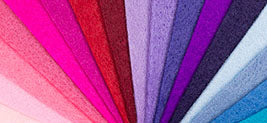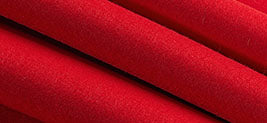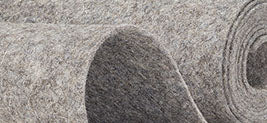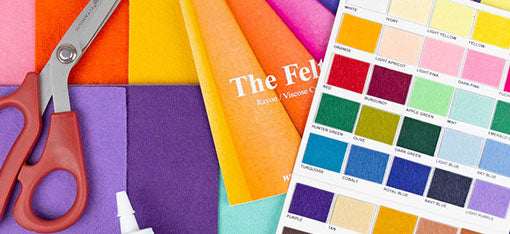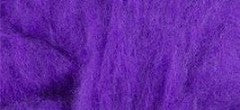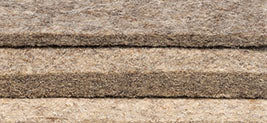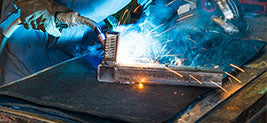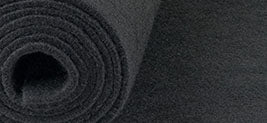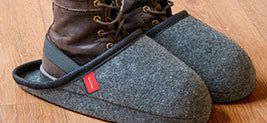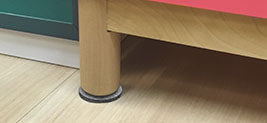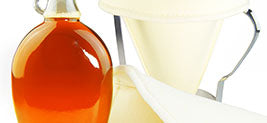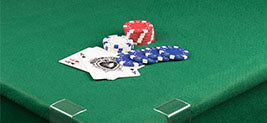All About Felt FAQ
Felt Characteristics
That is an excellent question! It was such a popular question that we decided to make a video to show you how felt is made. You can watch our Felt Making video here.
Felt is a versatile textile that can be made from the matting together of natural and/or synthetic fibers. There are two ways of manufacturing felt – Wet Felting which requires the application of moisture, heat and friction, and Needle Felting which interlocks fibers via the repetitive motion of needles. The star ingredient of felt is wool and is often found in high quality felts. On a microscopic level, wool has exposed edges of cuticle cells that point towards the tip of the fiber, creating a jagged edge. This allows fibers to slip over one another easily in one direction but not the other, giving wool the ability to felt. The more friction, heat and moisture is applied to wool, the more condensed and durable the material gets.
Felt is a versatile textile that can be made from the matting together of natural and/or synthetic fibers. There are two ways of manufacturing felt – Wet Felting which requires the application of moisture, heat and friction, and Needle Felting which interlocks fibers via the repetitive motion of needles. The star ingredient of felt is wool and is often found in high quality felts. On a microscopic level, wool has exposed edges of cuticle cells that point towards the tip of the fiber, creating a jagged edge. This allows fibers to slip over one another easily in one direction but not the other, giving wool the ability to felt. The more friction, heat and moisture is applied to wool, the more condensed and durable the material gets.
Natural fibers are produced by animals (wool) and plants (cotton) as fibrous materials. Natural fibers are produced by a living organism and decompose naturally over time. Synthetic fibers are derived from fossil-fueled/petroleum-based oils (polyester, acrylic, etc...) and generally stay in landfills and take several decades to decompose.
The dying process of felt is determined by the origin of fiber. Different fibers have different chemical make-ups and will bond differently when exposed to different dyes. These fiber types can be categorized into Protein Fibers, Cellulose Fibers, and Synthetic Fibers.
Protein fibers come from animals, such as wool, mohair or cashmere. Since wool is a protein fiber it can easily bond with Acid dyes. Our wools are dyed with low-impact Acid dyes that exhaust at temperatures between 160F and 180F, depending on the color. Once the dye bath is exhausted, the dye liquid can be neutralized with baking soda. Acid dyes are considered one of the most benign dyes available.
Cellulose fibers are plant-based fibers such as cotton. Cellulose fibers are dyed with fiber-reactive dyes that are generally low-impact synthetic dyes. The benefit of fiber reactive dye is that it forms a covalent bond with cellulose. Once the bond is formed, you have one molecule meaning that these types of dyes don’t fade or wash out easily.
Synthetic fibers are fibers made from humans through chemical synthesis. Examples of synthetic fibers are polyester, acrylic, and nylon. Synthetic dyes generally require dyes made out of complex molecular structures that do not readily decompose. Most synthetic dyes require toxic chemicals to help fix the dye to the fiber.
*Note: Rayon/Viscose is a fiber from regenerated cellulose, generally derived from wood pulp. Meaning that it can be considered both a cellulose and synthetic fiber.
Additional Resources on Dying Fibers:
Protein fibers come from animals, such as wool, mohair or cashmere. Since wool is a protein fiber it can easily bond with Acid dyes. Our wools are dyed with low-impact Acid dyes that exhaust at temperatures between 160F and 180F, depending on the color. Once the dye bath is exhausted, the dye liquid can be neutralized with baking soda. Acid dyes are considered one of the most benign dyes available.
Cellulose fibers are plant-based fibers such as cotton. Cellulose fibers are dyed with fiber-reactive dyes that are generally low-impact synthetic dyes. The benefit of fiber reactive dye is that it forms a covalent bond with cellulose. Once the bond is formed, you have one molecule meaning that these types of dyes don’t fade or wash out easily.
Synthetic fibers are fibers made from humans through chemical synthesis. Examples of synthetic fibers are polyester, acrylic, and nylon. Synthetic dyes generally require dyes made out of complex molecular structures that do not readily decompose. Most synthetic dyes require toxic chemicals to help fix the dye to the fiber.
*Note: Rayon/Viscose is a fiber from regenerated cellulose, generally derived from wood pulp. Meaning that it can be considered both a cellulose and synthetic fiber.
Additional Resources on Dying Fibers:
Felt can be dry cleaned, hand washed, or steam cleaned, however it should not be put in a washing machine or dryer. We recommend you treat felt like you would a wool sweater.
The color fastness of our felts is dependent on the fiber content and dye type used. Please see our FAQ on What type of dyes are used for felt for further details.
As a general rule our felts will bleed when exposed to hot water, friction and aggressive cleaning detergents. We recommend you treat felt like you would a wool sweater when washing to avoid the color from fading or bleeding.
As a general rule our felts will bleed when exposed to hot water, friction and aggressive cleaning detergents. We recommend you treat felt like you would a wool sweater when washing to avoid the color from fading or bleeding.
The light fastness of our felts is dependent on the fiber content and dye type used. Please see our FAQ on What type of dyes are used for felt for further details.
As a general rule our felts are not color fast. The color will fade when exposed to direct sunlight for extended periods of time.
As a general rule our felts are not color fast. The color will fade when exposed to direct sunlight for extended periods of time.
For best results we recommend using a lint roller to remove dust and lint from felt. Alternatively, felt can also be gently vacuumed.
Felt can be highly absorbent or it can also be naturally water repellant, depending on the density and quality of the felt. The higher the density of the felt, the more water repellant it will be.
Wool is naturally resistant to fire and is self-extinguishing. Our 100% wool felt meets commercial fire codes while our synthetic and blended felts must be treated for flame resistance.
Yes, felt can be printed on via screen printing and even some industrial laser printers. The higher the density of the felt, the better the clarity of the print.
Felt is an excellent way to absorb sound and/or create a specific acoustic environment for commercial or private spaces. As a general rule, the higher the wool content and the thicker the felt, the better the acoustic properties.
We recommend the following felt for acoustic applications:
100% Wool Designer Felt
F-5, F-7, or F-15 SAE Industrial Felt
100% Wool Craft Felt
Premium Wool Blend Craft Felt
We recommend the following felt for acoustic applications:
100% Wool Designer Felt
- Most commonly used for commercial applications such as sound studios, concerts halls, restaurants and offices.
- Recommended at 3mm and 5mm thick.
- 100% wool content is naturally fire resistant and meets commercial fire codes.
- Biodegradable.
- 100% VOC free.
- Contains no chemical irritants.
- Offers a clean finish and wide selection of colors.
F-5, F-7, or F-15 SAE Industrial Felt
- A more affordable alternative to 100% Wool Designer Felt.
- Recommended at 1/8” to 1/4" thick.
- High wool content will provide natural fire resistance. However, this product has not been commercially tested.
- Color and blemish variation will occur. If your project requires color consistency and a premium finish we recommend using our 100% Wool Designer Felt.
- Please note, that Industrial Felts are made from a mixture of wool and recycled fibers without being dyed. Due to the natural origin of the material, moths may be drawn to it. If you live in a residence with an existing moth problem, we recommend spraying the material with a moth resistant spray.
100% Wool Craft Felt
- A more affordable alternative to 100% Wool Designer Felt and SAE Industrial Felt.
- Only available in approx. 1.2mm thick.
- Due to the thin nature of the material, we recommend wrapping the felt around some kind of acoustic core; such as plywood or a poly board.
- 100% wool is naturally fire resistant. However, this product has not been commercially tested.
- Available in a variety of vibrant colors.
Premium Wool Blend Craft Felt
- Our most economical option.
- Due to the thin nature of the material, we recommend wrapping the felt around some kind of acoustic core; such as plywood or a poly board.
- This material has a lower wool content and fire resistance. It has not been commercially tested.
- Available in a variety of vibrant colors.
Yes, both wool and synthetic felts wick water. The Felt Store sells a synthetic felt specifically intended for the purpose of water irrigation called Kapmat.
Wool is also naturally hydrophilic, and can absorb up to 30% of it’s on weight. However due to the organic nature of wool, it is more likely to mold and decompose with time.
Wool is also naturally hydrophilic, and can absorb up to 30% of it’s on weight. However due to the organic nature of wool, it is more likely to mold and decompose with time.
You can stiffen felt by using starch sprays or white school glue. Read more about the process on our blog post called How to Stiffen Craft Felt.
Felt can certainly be custom dyed. Keep in mind that different fibers will hold dyes differently. For further details on how to dye wool and wool felts, please see our blog posts below:
No, our wool felts are not washed with the use of harmful chemicals and meet commercial standards. Our wools are washed using one or both of the below methods:
Scouring is a process of cleaning the greasy wool that was just sheared off the sheep. Wool will contain burs, grass, oils, urine and feces after being freshly shorn. The cleaning process can be as simple as a bath in warm water or as complicated as an industrial process using detergent and alkali in specialized equipment. Put simply, scouring is a cleaning process that removes the oils/grease from the freshly-sheared wool. It is likely that you can still find small impurities of burs and grass in the wool even after being scoured. White wools will often still maintain a yellowish tint after being scoured because the scouring process doesn’t completely strip the wool of all oils, fats and vegetable matter.
Carbonizing is a more intensive cleaning process that combines scouring to remove the wool grease and a chemical process that removes vegetable matter such as seeds, burs and grass from wool. The basic steps are:
Scouring is a process of cleaning the greasy wool that was just sheared off the sheep. Wool will contain burs, grass, oils, urine and feces after being freshly shorn. The cleaning process can be as simple as a bath in warm water or as complicated as an industrial process using detergent and alkali in specialized equipment. Put simply, scouring is a cleaning process that removes the oils/grease from the freshly-sheared wool. It is likely that you can still find small impurities of burs and grass in the wool even after being scoured. White wools will often still maintain a yellowish tint after being scoured because the scouring process doesn’t completely strip the wool of all oils, fats and vegetable matter.
Carbonizing is a more intensive cleaning process that combines scouring to remove the wool grease and a chemical process that removes vegetable matter such as seeds, burs and grass from wool. The basic steps are:
- Wool is immersed in a solution of Sulphuric Acid (H2S04).
- Then baked in a dryer at 95 to 120 degrees Celsius. This hardens the vegetable matter and turns it into carbon.
- The wool is then passed through a series of rollers that breaks up the carbonized matter and turns it into dust.
- Wool is then past through a de-dusting process that separates the dust from the wool.
- The wool acidity is then neutralized (PH 7) by passing it into a solution of alkali containing Sodium Carbonate (basically baking soda).
- The last step is to put the wool in a bath of bleach to kill additional bacteria and improve the color before the wool is dried. Carbonized wool has a clean finish with little to no impurities and a brighter color.
Cutting Felt
You can watch a short video of How to Cut Thick Felt here.
Most of our felts can be cut with a utility blade. We recommend that you score the felt multiple times with the utility blade until you cut through the felt.
Most of our felts can be cut with a utility blade. We recommend that you score the felt multiple times with the utility blade until you cut through the felt.
Generally felt that has a thickness between 1 to 2mm can be easily cut using the Circuit Maker. This includes the below felt:
We recommend using a rotary blade for thin felts and a knife blade for thick felt (2mm).
- Acrylic Craft Felt
- Rayon/Viscose Craft Felt
- Premium Wool Blend Craft Felt
- 1.2mm 100% Wool Craft Felt
- 2mm Thick 100% Wool Designer Felt
We recommend using a rotary blade for thin felts and a knife blade for thick felt (2mm).
Yes, any felt with a relatively high wool content can be laser cut. Wool is naturally flame resistant and will charcoal when exposed to flame rather than melt. Keep in mind, that since wool is hair, the laser cutting of wool felt will result in a strong hair burning scent and dark charcoaled edges.
The below felts are well suited for laser cutting:
The below felts are well suited for laser cutting:
Felt will not fray when it is cut as it is made of interlocking fibers. However, depending on the quality and use of the felt, it could begin to pill on the surface or edges.
Felt Adhesives
This is such a popular question; we have gone ahead and created a video for it. You can view our video on Industrial Adhesives here.
For light-duty applications we recommend purchasing one of our felts with an adhesive film on one side. Or applying an industrial spray adhesive.
For heavy-duty applications we would recommend using carpenters glue that can be absorbed deeper into the felt fibers.
For light-duty applications we recommend purchasing one of our felts with an adhesive film on one side. Or applying an industrial spray adhesive.
For heavy-duty applications we would recommend using carpenters glue that can be absorbed deeper into the felt fibers.
You can watch a short video on How to Peel Adhesive Felt here.
Our adhesive felt is very sticky. In order to peel the paper backing from the adhesive on the felt, you will have to separate the paper backing from the adhesive using your nails or carefully using a utility knife. Once you separate a corner, you should be able to peel the paper backing leaving the adhesive film on the felt. Please ensure that you are separating the adhesive from the paper backing and not the felt from the adhesive as this would tear your felt.
Our adhesive felt is very sticky. In order to peel the paper backing from the adhesive on the felt, you will have to separate the paper backing from the adhesive using your nails or carefully using a utility knife. Once you separate a corner, you should be able to peel the paper backing leaving the adhesive film on the felt. Please ensure that you are separating the adhesive from the paper backing and not the felt from the adhesive as this would tear your felt.
Approximately 2 Years. This is dependent on factors such as exposure to direct sunlight and humidity.
Product Specific
This is an excellent question! It was such a popular question that we decided to write a blog about it. You can read the full blog post entitled; SAE Industrial Felt 101: The Basics here.
SAE Industrial felts are usually not dyed and made from a mixture of wool, viscose, synthetics and recyclable fibers. The difference between SAE Industrial Felts can be determined by wool content, density, tolerance, application, durability, and color. If you would like to know which felt would be best for your application, you can contact one of our Customer Service Representatives and we would be happy to provide further guidance. For information on the F numbers, please see What do the F numbers for the Industrial Felts stand for and what do they mean?
SAE Industrial felts are usually not dyed and made from a mixture of wool, viscose, synthetics and recyclable fibers. The difference between SAE Industrial Felts can be determined by wool content, density, tolerance, application, durability, and color. If you would like to know which felt would be best for your application, you can contact one of our Customer Service Representatives and we would be happy to provide further guidance. For information on the F numbers, please see What do the F numbers for the Industrial Felts stand for and what do they mean?
The F numbers are an industry standard of grading and categorizing wool felts that is established by the SAE (Society of Automotive Engineers). SAE is a standard of measurement applied to felts used for industrial applications. These applications often require high durability with resistance to abrasion and wear. The F number is based on the wool content, density, and tolerance of the felt at each thickness. Each grade of felt has recommended uses. To learn more about SAE felts, you can read our blog post entitled, SAE Industrial Felt 101: The Basics here.
If you are looking for felt for a particular use, you can contact one of Customer Service Representatives who would be happy to assist you further.
If you are looking for felt for a particular use, you can contact one of Customer Service Representatives who would be happy to assist you further.
We offer ready-made Wool Ironing Mats in a variety of sizes on our website. The felt for our Wool Ironing Mats is made from a specialty wool blend not available in bolt form.
However, any thick felt with a high wool content can act as an alternative. We recommend the below SAE Industrial Felts as alternatives:
Please note: Our industrial felts are made with wool that comes from free-roaming sheep. Although felt is washed and carbonized there may be some vegetable matter and other debris lingering in the coat. Due to the natural origin of the material slight color variation will occur from lot to lot. Sheep hair comes in a variety of beige and gray tones, making it difficult to guarantee consistent color between rolls without dying the material.
However, any thick felt with a high wool content can act as an alternative. We recommend the below SAE Industrial Felts as alternatives:
Please note: Our industrial felts are made with wool that comes from free-roaming sheep. Although felt is washed and carbonized there may be some vegetable matter and other debris lingering in the coat. Due to the natural origin of the material slight color variation will occur from lot to lot. Sheep hair comes in a variety of beige and gray tones, making it difficult to guarantee consistent color between rolls without dying the material.
When wool is exposed to moisture and heat it has a natural scent of wet hair to it. Wool is flame resistant and naturally absorbs heat and distributes it evenly; making it the key ingredient in wool ironing mats.
We suggest using felts with a higher density and thickness for making handbags. Our top recommendations are:
100% Wool Designer Felt
F-3, F-5, F-7 or F-10 SAE Industrial Felt
100% Wool Designer Felt
- Most commonly used for commercial products.
- Recommended at 3mm and 5mm thick. Most sewing machines can handle sewing together two layers of 3mm thick designer felt (6mm total). Anything above this thickness will likely require an industrial sewing machine.
- Offers a clean finish and wide selection of colors.
F-3, F-5, F-7 or F-10 SAE Industrial Felt
- A more affordable alternative to 100% Wool Designer Felt.
- Recommended at 1/8” and 1/4" thick.
- Color and blemish variation will occur. If your project requires color consistency and a premium finish we recommend using our 100% Wool Designer Felt.
- Please note, that Industrial Felts are made from a mixture of wool and recycled fibers without being dyed. Due to the natural origin of the material, moths may be drawn to it. If you live in a residence with an existing moth problem, we recommend spraying the material with a moth resistant spray.
Scouring is a process of cleaning the greasy wool that was just sheared off the sheep. Wool will contain burs, grass, oils, urine and feces after being freshly shorn. The cleaning process can be as simple as a bath in warm water or as complicated as an industrial process using detergent and alkali in specialized equipment. Put simply, scouring is a cleaning process that removes the oils/grease from the freshly-sheared wool. It is likely that you can still find small impurities of burs and grass in the wool even after being scoured. White wools will often still maintain a yellowish tint after being scoured because the scouring process doesn’t completely strip the wool of all oils, fats and vegetable matter.
Carbonizing is a more intensive cleaning process that combines scouring to remove the wool grease and a chemical process that removes vegetable matter such as seeds, burs and grass from wool. The basic steps are:
Carbonized wool has a clean finish with little to no impurities and a brighter color.
Carbonizing is a more intensive cleaning process that combines scouring to remove the wool grease and a chemical process that removes vegetable matter such as seeds, burs and grass from wool. The basic steps are:
- Wool is immersed in a solution of Sulphuric Acid (H2S04).
- Then baked in a dryer at 95 to 120 degrees Celsius. This hardens the vegetable matter and turns it into carbon.
- The wool is then passed through a series of rollers that breaks up the carbonized matter and turns it into dust.
- Wool is then passed through a de-dusting process that separates the dust from the wool.
- The wool acidity is then neutralized (PH 7) by passing it into a solution of alkali containing Sodium Carbonate (basically baking soda).
- The last step is to put the wool in a bath of bleach to kill any remaining bacteria and improve the color before the wool is dried.
Carbonized wool has a clean finish with little to no impurities and a brighter color.
 USA
USA CANADA
CANADA EUROPE
EUROPE